To identify satin, look for its glossy, smooth surface that beautifully reflects light. You'll notice a soft and silky feel, often making it comfortable against your skin. Satin typically has a heavier drape, adding structure to garments and decor. Remember that genuine silk satin will feel luxurious, while synthetic options like polyester may lack that same comfort. Snagging is common, so handle it gently. If you want to learn about different types of satin and tips for ensuring you're picking the right fabric for your needs, there's much more to explore.
Understanding Satin Fabric
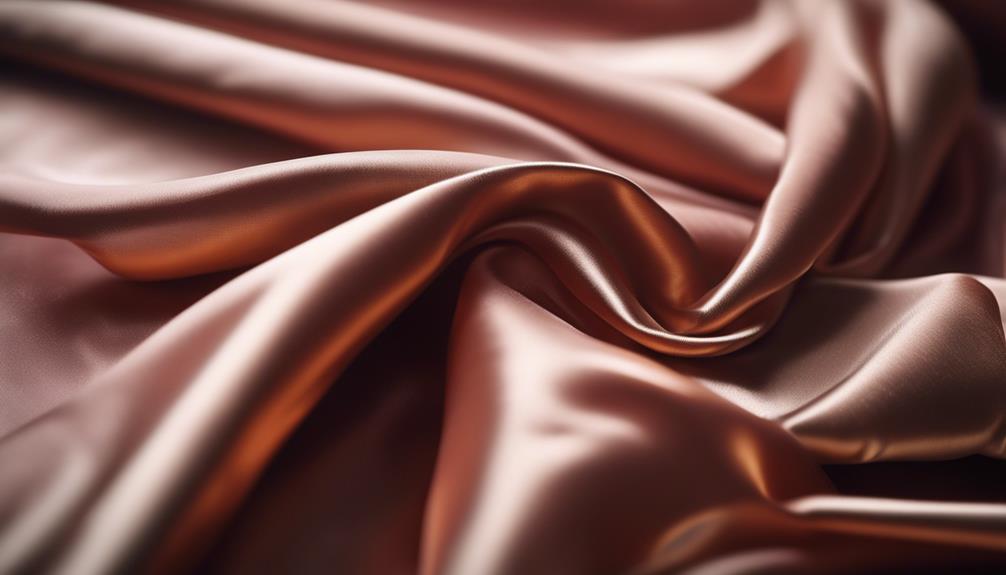
Satin is a unique fabric that stands out due to its glossy, smooth finish, which gives it an elegant look. The satin weave is what sets it apart, allowing light to reflect beautifully off its surface. You'll often find satin made from silk fabric, known for its soft and smooth texture that feels luxurious against your skin. However, not all satin is created equal; it can also be crafted from synthetic satin, like polyester or nylon, which offers different qualities and price points.
When you touch satin, you'll notice its smooth and lustrous feel, ideal for garments such as evening wear, lingerie, and accessories. The fabric's durability depends on the fibers used—silk satin is incredibly breathable and luxurious, while polyester satin is more affordable and wrinkle-resistant.
Caring for satin requires some attention; a gentle hand wash or a delicate machine cycle is usually best. You'll want to avoid snagging to maintain its glossy appearance. Understanding these characteristics will help you appreciate the versatility of satin and make informed choices when selecting this luxurious fabric for your wardrobe.
Types of Satin Materials
When exploring the different types of satin materials, you'll find that they come in a variety of fibers, each bringing its own unique characteristics to the table. Here's a quick overview of some common satin types:
| Type of Satin | Characteristics |
|---|---|
| Silk Satin | Luxurious feel, breathable, ideal for high-end garments and sleepwear. |
| Polyester Satin Fabric | Affordable, durable, wrinkle-resistant, often used in clothing and home decor. |
| Rayon Satin | Inexpensive, moisture-wicking, suitable for both casual and formal wear. |
Each type of satin has its distinct advantages. For instance, silk satin is the epitome of luxury, offering a soft feel that's hard to beat. On the other hand, polyester satin fabric is made from synthetic fibers, making it a practical choice for everyday wear. If you're looking for something that balances cost and comfort, rayon satin might be the way to go. Finally, acetate satin provides a soft, wrinkle-resistant option, perfect for formalwear and home textiles. Understanding these options helps you make informed choices when selecting satin for your needs.
Key Characteristics of Satin
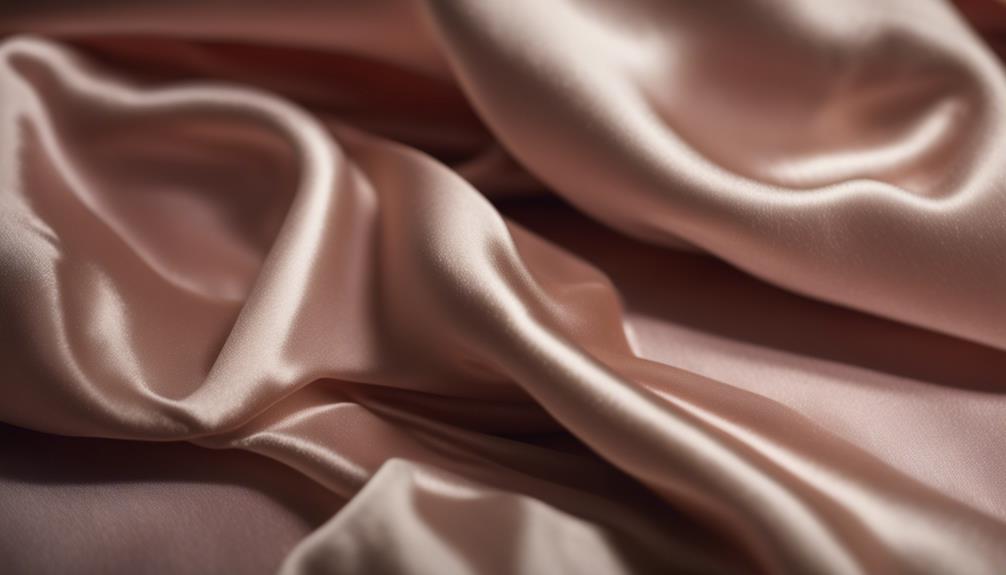
Understanding the different types of satin materials lays the groundwork for recognizing the key characteristics that define this luxurious fabric. Satin is distinguished by several unique traits that contribute to its appeal.
- Smooth and Glossy Surface: The weaving technique creates long, floating yarns, resulting in a fabric that's irresistibly smooth and has a glossy finish.
- Soft and Silky Feel: When you touch satin, you'll notice its soft and silky texture, making it incredibly comfortable against your skin, perfect for garments that hug your body.
- Heavier Drape: Unlike lighter fabrics, satin offers a heavier drape, giving it a structured appearance, which is ideal for formal wear and elegant evening attire.
- Breathability: Satin's breathability can vary; silk satin tends to be more breathable than synthetic options like polyester satin, which might feel stifling in warmer temperatures.
However, be cautious—satin features a delicate weave that makes it prone to snagging. Handling it with care will help maintain its luxurious appearance, ensuring you enjoy this exquisite fabric for years to come.
Comfort Comparison With Silk
Comfort is key when choosing fabrics, and silk stands out as the superior option compared to satin. When you touch silk, you immediately notice its smooth and soft feel, thanks to its natural protein fibers. In contrast, polyester satin can feel cheap and synthetic, lacking the luxurious softness you crave.
Silk offers exceptional breathability and thermoregulation, ensuring your comfort in both summer and winter climates. Satin simply can't replicate these qualities, often leaving you feeling sticky or chilly. Over time, silk maintains its exquisite feel, while satin may become less appealing and prone to snagging.
If you have sensitive skin, silk's natural fibers provide hypoallergenic properties, making it a far better choice than synthetic satin. For sleepwear and intimate apparel, silk is certainly recommended, as it delivers unrivaled comfort and softness that you'll appreciate night after night.
Cost Differences Between Satin and Silk
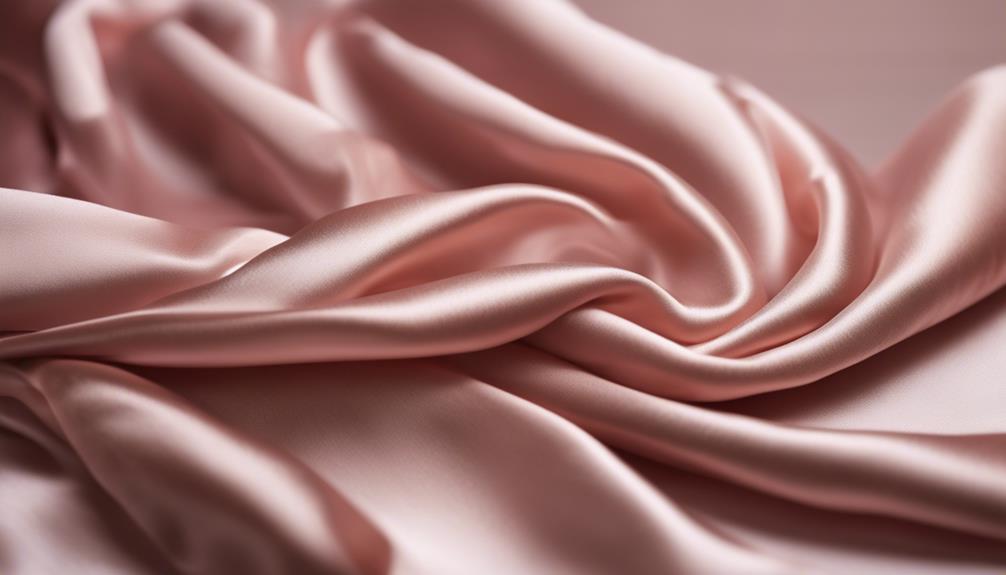
The cost differences between satin and silk can greatly impact your fabric choices. Satin, primarily made from synthetic fibers like polyester, is much cheaper to produce than silk. This lower production cost often makes satin an attractive option for budget-conscious shoppers. However, it's crucial to understand what you're sacrificing regarding quality and feel.
Here are four key points to keep in mind:
- Production Costs: Satin is less expensive because it involves simpler manufacturing processes, while silk requires labor-intensive harvesting from silkworms.
- Quality Variability: Genuine silk can vary in price and quality, often commanding a premium due to its luxurious feel and durability.
- Environmental Impact: Satin production frequently utilizes toxic chemicals, while silk is derived from natural protein fibers, making it a more eco-friendly choice.
- Longevity and Strength: Silk threads exhibit impressive tensile strength, outlasting satin in durability, which justifies the higher price tag.
Identifying Genuine Silk
Often mistaken for synthetic alternatives, genuine silk can be identified through its unique characteristics. When you touch genuine silk, you'll notice it has a soft and luxurious feel with a wax-like texture. In contrast, synthetic satin often feels slippery and plastic-like. If you gently rub the fabric, silk generates heat and produces a slight crunching sound when gathered—something synthetic satin doesn't do.
Another telltale sign is the fabric's luster. Genuine silk exhibits a smooth and glossy sheen that changes with the angle of light, providing an elegant appearance. This depth of sheen is absent in synthetic satin, which tends to look overly glossy and lacks consistency. When you closely inspect the fabric under different lighting conditions, genuine silk maintains a natural glow, highlighting the difference between satin and silk.
To differentiate between the two, pay attention to any variations in shine and texture. Genuine silk has a consistent sheen, while synthetic satin may show unevenness. By focusing on these key characteristics, you'll easily identify genuine silk and appreciate its unique qualities.
Care and Maintenance Tips
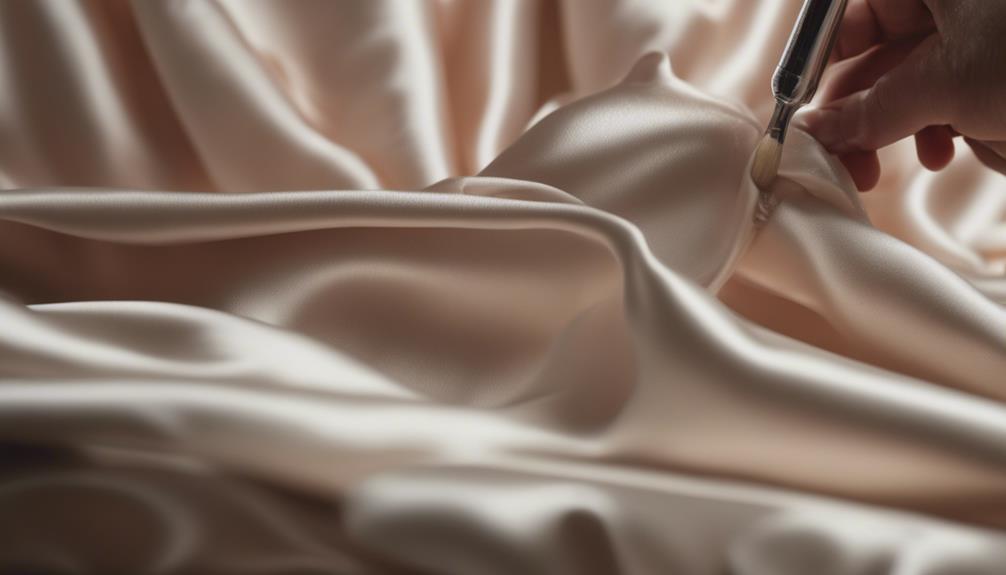
When it comes to caring for satin, proper maintenance is key to preserving its beauty and longevity. Here are some essential tips to help you keep your satin looking its best:
- Hand Washing: Always opt for hand washing with cool water and a mild detergent. This prevents damage and maintains the fabric's integrity. If you must use a machine, choose a gentle cycle without fabric softeners.
- Air Drying: After washing, lay your satin flat on a clean towel to air dry. Avoid direct sunlight to prevent fading and damage. Never wring or twist the fabric.
- Ironing: If your satin needs ironing, use a cool iron and place a pressing cloth between the iron and the fabric. This protects the satin from burns and unwanted shine.
- Storage: Store satin garments by folding them neatly or hanging them on hangers designed for delicate fabrics. This helps maintain their shape and prevents wrinkling.
Common Uses of Satin
Satin's versatility makes it a favorite choice for various applications, from elegant evening wear to cozy sleep attire. You'll often find satin in formal garments like evening gowns and bridesmaid dresses, thanks to its luxurious appearance and smooth texture. Wearing satin instantly elevates your look, making it perfect for special occasions or events.
In addition to formal wear, satin is an excellent choice for sleepwear. Its soft and sensual feel against the skin enhances your comfort during sleep, allowing you to indulge in a restful night. If you're considering updating your home decor, satin can add an elegant touch to your interiors. Its glossy finish makes it ideal for upholstery and decorative cushions, giving any room a sophisticated vibe.
Satin doesn't stop there; you'll also see it in stylish accessories like evening bags, ties, and sashes, where its sheen contributes to a chic finish. Furthermore, it's frequently used in theatrical costumes and performance wear, as the fabric's ability to catch the light creates striking visual effects on stage. Satin truly shines, making it a go-to fabric for a variety of stylish applications.
Sustainable Satin Options
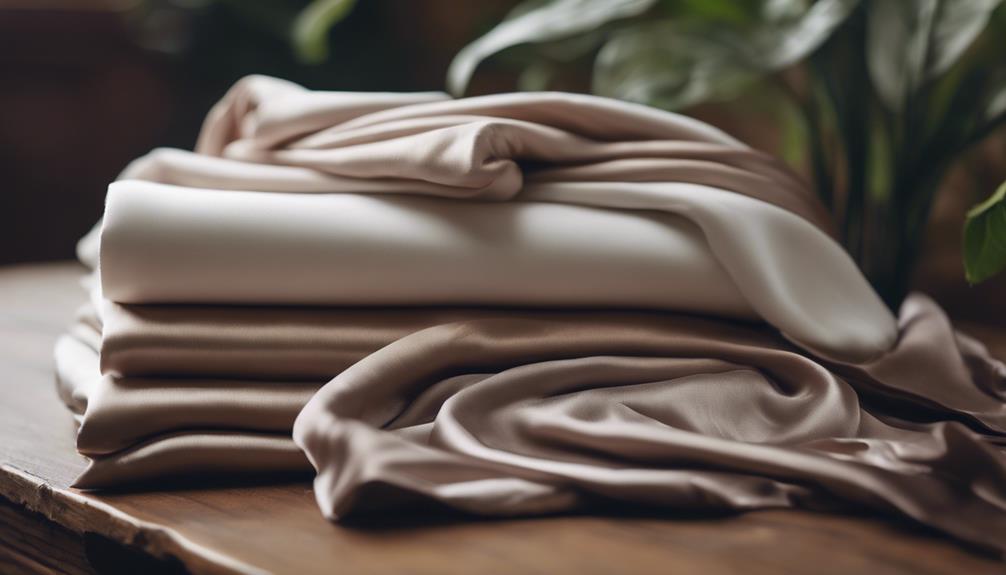
As you explore the various uses of satin, consider the growing availability of sustainable options that align with eco-friendly values. Choosing sustainable satin not only supports environmentally conscious practices but often results in higher quality fabrics designed to last longer. Here are some sustainable satin options you can look for:
- TENCEL™ Modal: This fiber is derived from certified wood sources and supports responsible forestry practices, making it a great eco-friendly choice.
- Recycled Polyester: Many brands now produce satin using recycled polyester, minimizing waste and reducing the environmental impact of new synthetic fiber production.
- Organic Materials: Satin made from organic cotton or sustainably sourced silk contributes to a more environmentally friendly fashion landscape.
- Eco-Labels: Look for satin products certified by eco-labels like the EU Ecolabel, which guarantee strict adherence to environmental standards during production.
Testing for Fabric Authenticity
Identifying the authenticity of satin is essential, especially if you're looking to invest in high-quality fabrics. To guarantee you're getting the real deal, you can perform a couple of tests. One reliable method is the burn test. Take a small swatch of the fabric and carefully burn it. Genuine silk will burn slowly, giving off a smell similar to burning hair, and it will leave behind fine ash. In contrast, artificial silk will melt and produce a distinct plastic odor.
Another method is the silk ring test. Try to slip a small silk item, like a scarf, through a ring. This technique is less effective for larger fabrics, but it can still provide some insight.
Pay attention to the look and feel of the fabric, too. Genuine silk feels smoother but isn't as slippery as synthetic satin, which tends to be more slippery and has a plastic-like texture. Always request a swatch sample before purchasing silk items, as testing authenticity on valuable fabrics is best avoided. By using these techniques, you can confidently identify authentic satin and make informed decisions in your fabric investments.
Frequently Asked Questions
How to Tell if It's Real Satin?
To tell if it's real satin, examine its smooth, soft surface and substantial weight. Feel the fabric against your skin; genuine satin should feel luxurious, not slick. Check labels for silk content too.
How to See if Something Is Satin?
To see if something's satin, feel its smoothness and check for a glossy surface. Look for a heavier drape and examine the reverse side—it should be dull compared to the shiny front.
How to Tell Satin Vs Silk?
To tell satin from silk, feel for the texture; silk's soft and smooth, while satin's often slippery. Check the shine, too—silk has a natural glow, whereas satin can be overly shiny.
What Does Real Satin Look Like?
Real satin has a smooth, shiny surface that catches light beautifully. You'll notice its heavier drape and soft, silky feel against your skin, distinguishing it from cheaper, synthetic alternatives that lack true luxury.
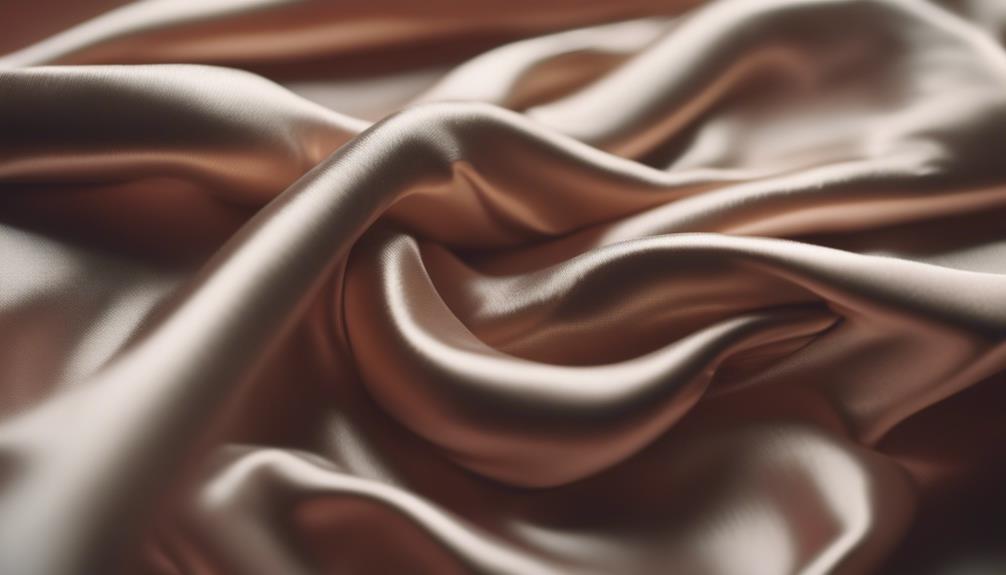

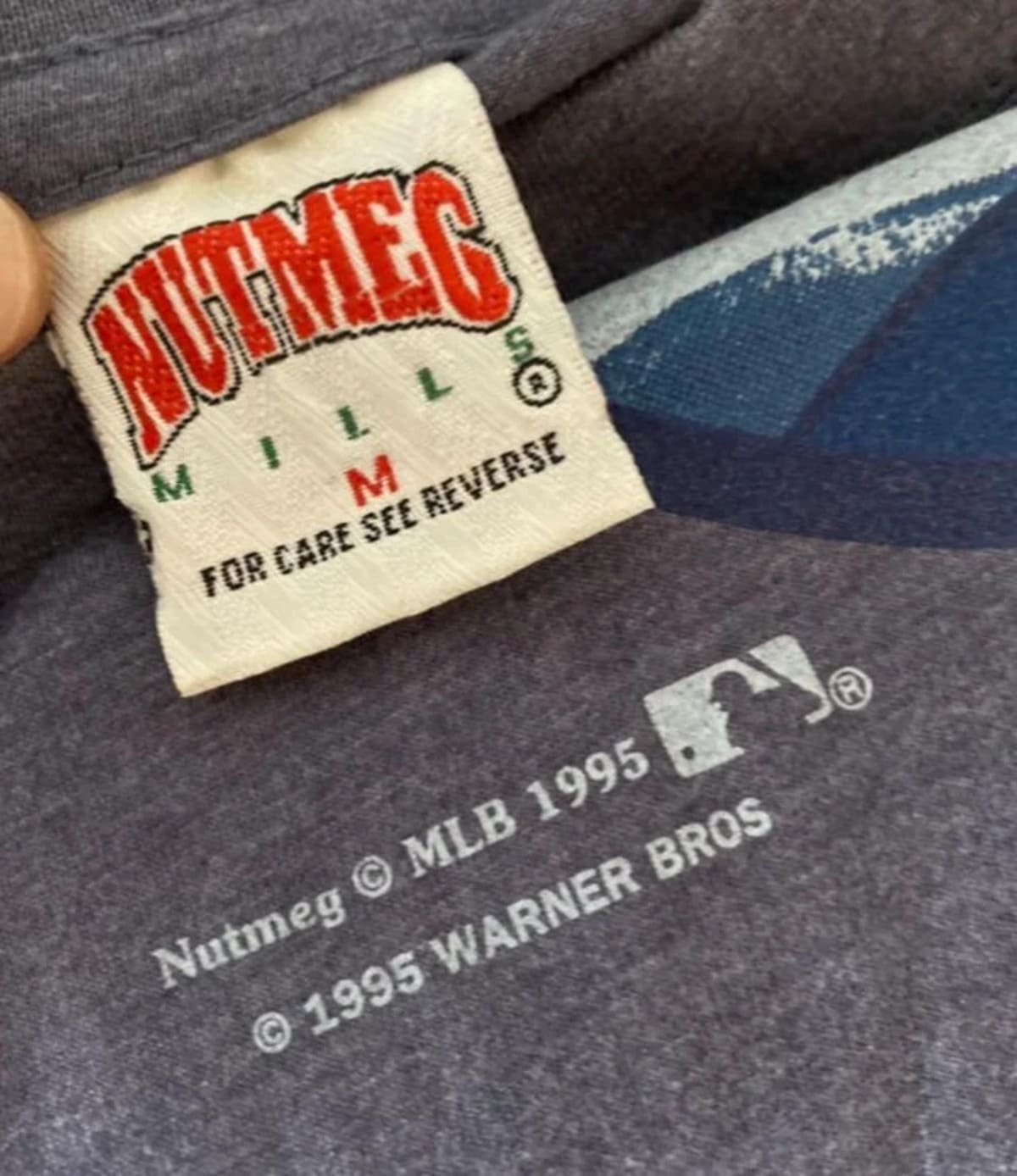


Thank you for your sharing. I am worried that I lack creative ideas. It is your article that makes me full of hope. Thank you. But, I have a question, can you help me?
Your point of view caught my eye and was very interesting. Thanks. I have a question for you.